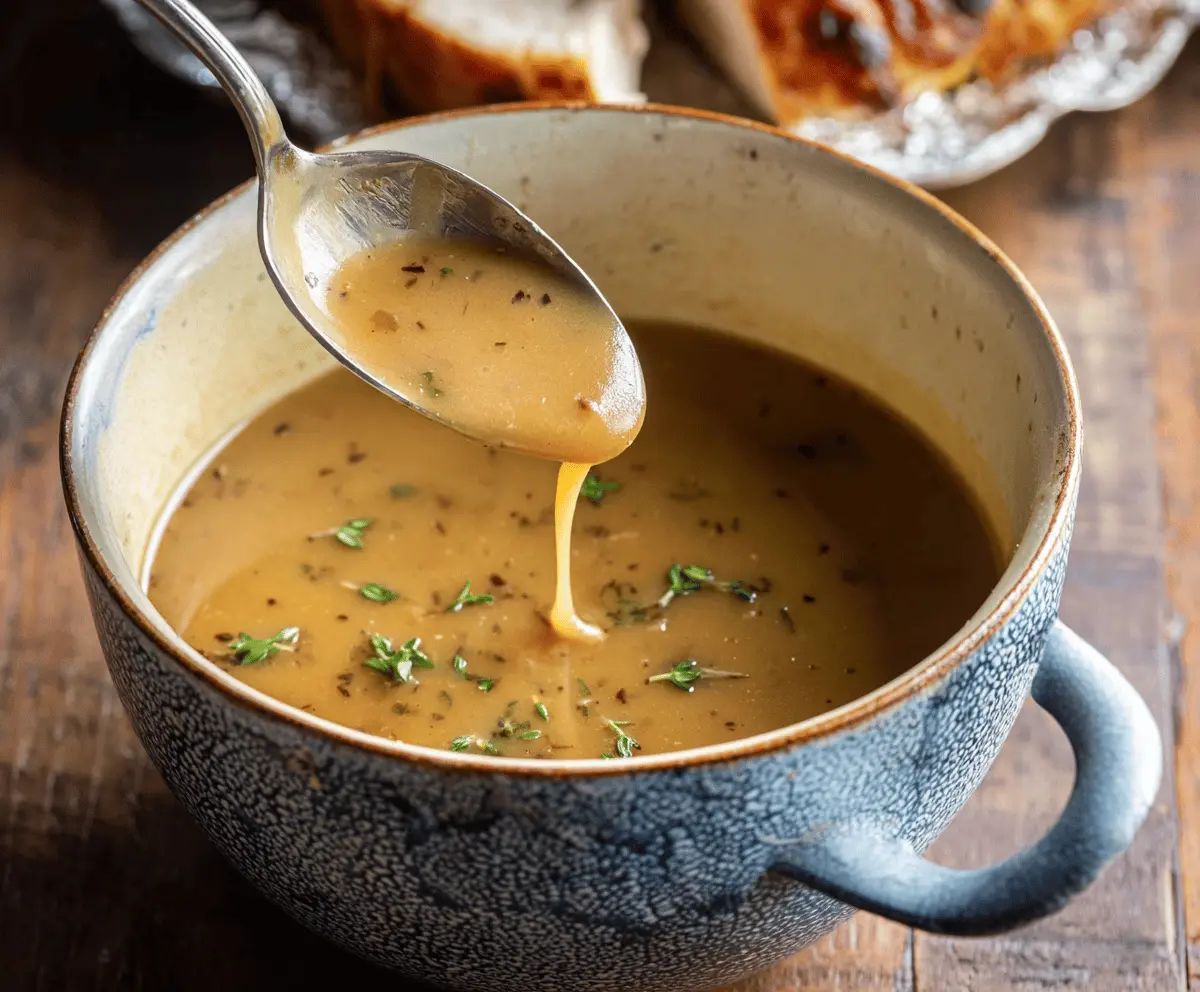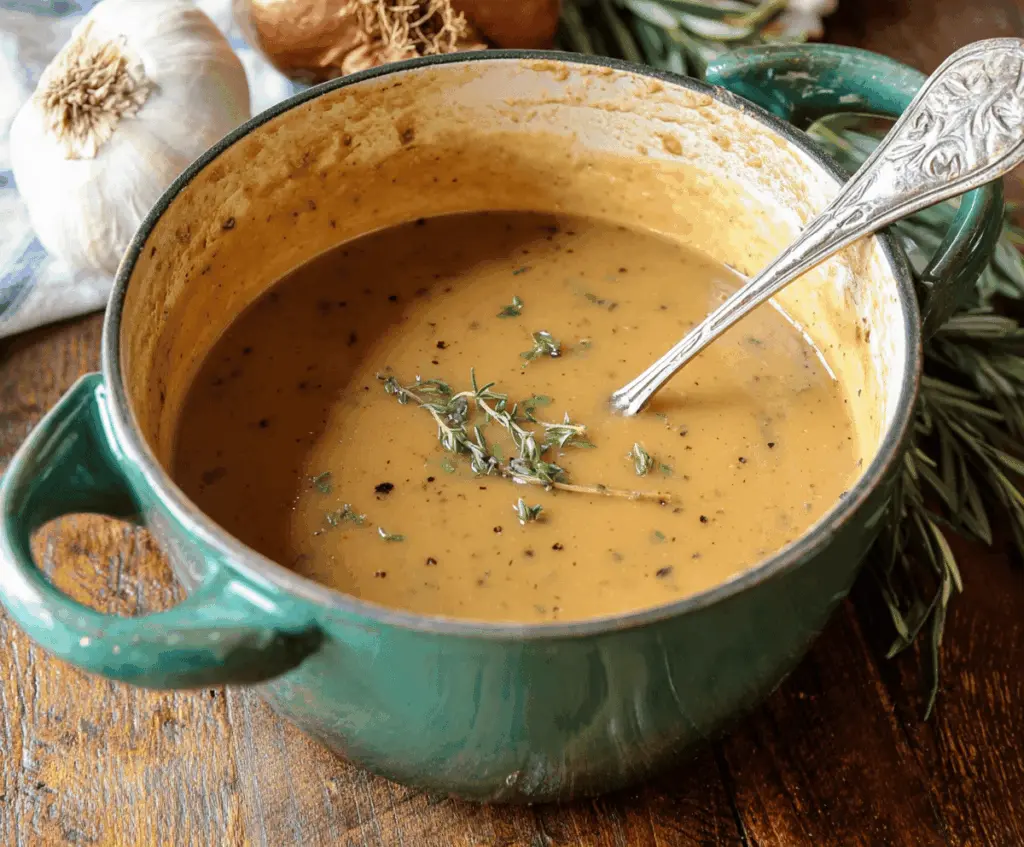Perfect Turkey Gravy is the ultimate finishing touch to any holiday meal or Sunday dinner. It’s rich, silky, and full of that deep turkey flavor you get from all those pan drippings and a little extra love. The texture is just right—thick enough to coat your plate but smooth enough to pour over every bite.
I always make a double batch because, honestly, you can never have too much gravy. My secret is to whisk in a bit of turkey stock or broth along with the drippings to make it extra flavorful. I love that moment when it thickens on the stove, and the whole kitchen starts smelling like comfort and tradition.
One of my favorite ways to enjoy this gravy is smothering it over a big slice of roasted turkey and mashed potatoes, but it’s also fantastic drizzled over stuffing or even roasted vegetables. It brings everything together and makes the meal feel cozy and complete. Whenever I make this gravy, I’m reminded of family gatherings and the warm, happy chaos that comes with sharing good food.
Key Ingredients & Substitutions
Turkey drippings: These give your gravy that rich, authentic flavor. If you don’t have drippings, use butter or oil with turkey broth for a tasty alternative. You can also add a splash of soy sauce for extra depth.
Stock: Homemade turkey or chicken stock is best for flavor. When unavailable, low-sodium store-bought broth works fine. Avoid salty broths to keep the seasoning balanced.
All-purpose flour: Flour thickens the gravy into that smooth, creamy texture. If gluten-free is needed, try cornstarch or arrowroot powder but add it gradually to prevent clumping.
Butter: Unsalted butter adds richness. You can replace it with olive oil or turkey fat if you want a lighter option or deeper taste.
Fresh thyme: Fresh herbs brighten the gravy’s flavor. Dried thyme is okay but use less, about half the amount.
How Do You Get Turkey Gravy Smooth and Clump-Free?
Making smooth gravy can be tricky when adding flour and liquids. The secret is to cook the roux slowly and whisk constantly.
- Start by cooking the flour in fat until golden, stirring often to prevent lumps or burning.
- Slowly add warm stock in small amounts while whisking vigorously, which helps break up lumps right away.
- Keep the heat moderate to avoid rapid thickening or scorching on the bottom.
- If lumps form, strain the gravy through a fine sieve or whisk vigorously to smooth it out.
Patience is key. Take your time during the roux stage and the gradual liquid addition. This creates that silky, velvety gravy to make your turkey dinner shine.

Equipment You’ll Need
- Measuring cups and spoons – For measuring drippings, stock, and seasonings, so everything turns out just right.
- Fat separator or fine-mesh sieve – To separate the flavorful fat from the drippings, making your gravy less greasy and more flavorful.
- Medium saucepan – For cooking the gravy on the stove, giving you plenty of room to whisk and simmer.
- Whisk – Keeps the gravy smooth and prevents lumps while you cook and thicken.
- Fine-mesh sieve (optional) – To strain out any lumps for extra silky gravy, if you prefer a super smooth finish.
Flavor Variations & Add-Ins
- Herb twist: Swap thyme for rosemary or sage to match your turkey seasonings and add a different aroma.
- Spicy kick: Stir in a pinch of cayenne or hot sauce for some heat that pairs nicely with gamey meats.
- Wine or sherry: Add a splash of white wine or sherry during simmering for a richer, more complex flavor.
- Mushrooms: Sauté sliced mushrooms with onions for an earthy boost that goes great with turkey or chicken.
Perfect Turkey Gravy
Ingredients You’ll Need:
- 1/4 cup turkey drippings (from roasted turkey)
- 4 cups turkey or chicken stock (preferably homemade or low sodium)
- 1/4 cup all-purpose flour
- 2 tablespoons unsalted butter
- 1/2 teaspoon fresh thyme leaves (plus extra for garnish)
- 1 small onion, finely chopped (optional)
- 1 clove garlic, minced (optional)
- Salt and freshly ground black pepper to taste
How Much Time Will You Need?
This gravy recipe takes about 15 minutes to make from start to finish. It’s a quick process that fits easily into your turkey roasting schedule, especially if you prepare the drippings while the turkey rests.
Step-by-Step Instructions:
1. Collect and Prepare the Drippings:
After roasting your turkey, carefully pour the drippings from the pan into a measuring cup or fat separator. Let the fat rise to the top, then skim off and reserve about 1/4 cup of this fat along with any browned bits. These will add rich flavor to your gravy.
2. Make the Roux and Sauté Aromatics:
Place a medium saucepan over medium heat and add the reserved turkey fat. If you don’t have enough fat, add butter to make up 2 tablespoons. For more flavor, add the finely chopped onion and cook until softened, about 3–4 minutes. Then add the minced garlic and cook for another 30 seconds.
3. Cook the Flour and Add Stock:
Whisk in the flour and cook, stirring constantly, until the mixture turns golden brown and bubbly—this takes about 2 to 3 minutes and creates the roux that will thicken your gravy. Gradually whisk in the turkey or chicken stock, making sure to break up any lumps as you add it.
4. Simmer and Season:
Bring the mixture to a gentle boil, then reduce the heat and let it simmer for about 10 minutes until thickened to your liking. Stir occasionally to prevent sticking. Add fresh thyme leaves, then taste and season with salt and freshly ground black pepper.
5. Finish and Serve:
For an extra smooth texture, strain the gravy through a fine-mesh sieve. Garnish with a sprig of fresh thyme and serve warm over your turkey, mashed potatoes, or stuffing.
This comforting turkey gravy is rich, smooth, and perfect for making your holiday meal truly special. Enjoy!
Can I Use Store-Bought Broth Instead of Homemade Stock?
Yes! Just choose a low-sodium broth so you can control the saltiness of the gravy. Homemade stock adds extra depth, but store-bought works well in a pinch.
How Can I Make My Gravy Thicker or Thinner?
To thicken, simmer the gravy a bit longer to reduce the liquid or add a little extra flour mixed with water. For a thinner gravy, simply whisk in more stock until you reach your preferred consistency.
Can I Prepare Turkey Gravy Ahead of Time?
Absolutely! Make the gravy up to 2 days in advance and store it in the fridge. Reheat gently on the stove, stirring frequently and adding a splash of stock if needed to loosen it.
What Should I Do If My Gravy Has Lumps?
Don’t worry! Pour the gravy through a fine-mesh sieve to remove lumps or whisk it vigorously while reheating. Adding the stock gradually when whisking in the flour also helps prevent lumps from forming.



